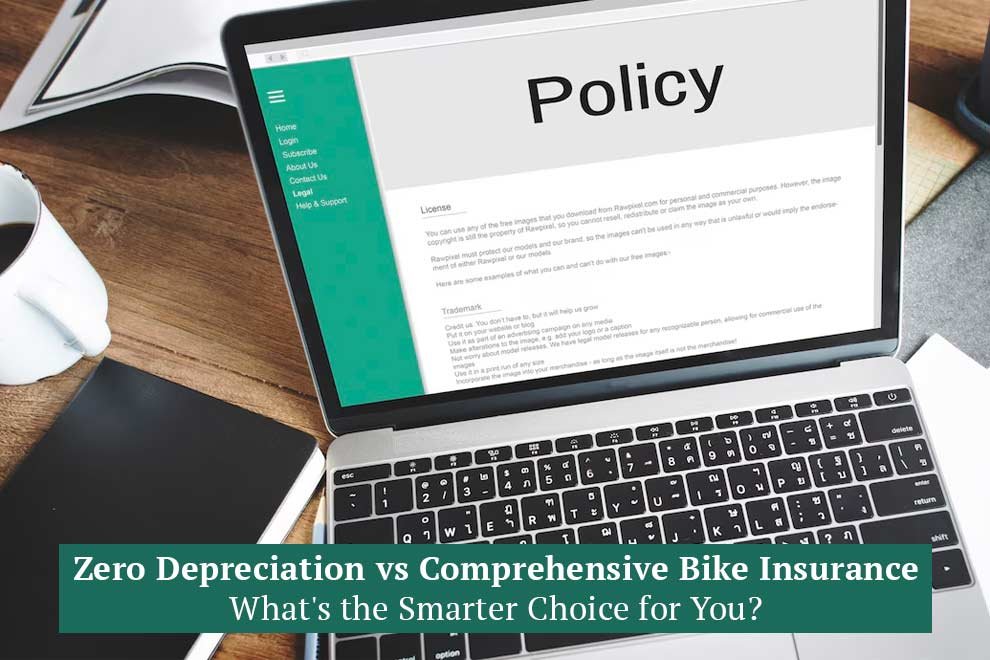Securing a bike with the appropriate insurance policy is crucial, but navigating the choice between zero depreciation and comprehensive coverage can be confusing. Comprehensive insurance provides coverage for damages to your bike, as well as third-party liabilities, but it also factors in depreciation. Thus, reducing the amount you would receive on your claim.
Alternatively, a zero depreciation cover allows you to receive full reimbursement for repairs without accounting for depreciation or wear and tear. It is more expensive than comprehensive coverage, but it allows for broader financial protection.
You must weigh the benefits, costs, and coverage of both options to decide which one suits you best. Read on to discover their differences and make an informed choice for more effective protection.
What is Comprehensive Bike Insurance?
A comprehensive bike insurance policy protects against third-party liability and damage to your bike. It protects you against accidents, theft, and damage caused by natural or man-made disasters.
The comprehensive policy covers the costs associated with repairing or replacing your bike if it sustains severe damage or is written off in an accident. Compared to a third-party policy, comprehensive insurance provides significantly wider coverage for both vehicles and passengers, while significantly reducing out-of-pocket expenses in the event of an accident.
What is Zero Depreciation Bike Insurance?
Zero depreciation bike insurance is often provided as an add-on cover to your comprehensive policy. Zero depreciation eliminates any deductions for depreciation included in the claim settlement, which will maximise the reimbursement of damages to your bike.
Generally, insurers will discount the costs associated with your bike repairs based on the age of the bike and its components. Zero depreciation means you receive all the costs related to bike repairs without any depreciation on the claim amounts.
For newer bikes and expenses associated with repairs, add-on coverage for zero depreciation provides valuable financial protection for your bike’s repairs. The initial premium costs may be higher, but zero depreciation will greatly reduce the unexpected costs associated with repairs after an unfortunate event.
Difference Between Zero Depreciation vs. Comprehensive Bike Insurance
Choosing the right bike insurance requires understanding the key differences between zero depreciation and comprehensive insurance. Both policies offer financial protection, but they vary in terms of coverage, cost, and claim benefits. Here’s a detailed comparison table highlighting their key differences:
| Aspect | Comprehensive Bike Insurance | Zero Depreciation Bike Insurance |
| Coverage Scope | Covers own damages, third-party liabilities, theft, and damages from natural or man-made disasters. | Offers the same coverage as comprehensive insurance, with additional protection against depreciation deductions on replaced parts. |
| Depreciation Deduction | Depreciation is deducted during claim settlements, reducing the reimbursed amount. | No depreciation is deducted; full cost of replaced parts is reimbursed. |
| Premium Cost | Generally lower due to standard coverage. | Higher than standard comprehensive insurance because of the added benefit of covering depreciation. |
| Claim Settlement Amount | Reduced due to depreciation deductions on parts. | Higher, as the insurer covers the full cost without accounting for depreciation. |
| Add-on Availability | Standalone policy; can be enhanced with various add-ons, including zero depreciation. | Not a standalone policy; must be purchased as an add-on to a comprehensive plan. |
| Best Suited For | Riders seeking balanced coverage at a moderate premium. | Owners of new, luxury, or expensive bikes aiming to minimise out-of-pocket expenses for repairs. |
| Impact of Bike’s Age | Depreciation increases with the bike’s age, leading to lower claim amounts over time. | Particularly beneficial for new bikes; may be less advantageous for older models due to policy terms. |
| Policy Requirement | Mandatory to have at least third-party coverage; comprehensive is optional but recommended. | Optional add-on; requires an existing comprehensive policy. |
| Financial Protection | Provides substantial coverage but may involve higher out-of-pocket expenses due to depreciation. | Offers enhanced financial protection by covering full repair costs without depreciation deductions. |
How to Choose the Right Option?
Choosing between comprehensive bike insurance and zero-depreciation bike insurance requires thoughtful consideration of your situation and needs. Here are some key points that you must evaluate:
Age & Value of Your Bike
If you own a newer or more valuable bike, you will benefit from maximum coverage with a zero depreciation add-on, as you won’t have to worry about depreciation adjustments. In the case of an older bike, it would be up to you to decide whether you prefer a comprehensive policy, given that the bike’s value has already depreciated.
Your Premium Budget
Comprehensive bike insurance offers standard coverage at a more reasonable premium price. Suppose you can afford a higher premium with no out-of-pocket expenses in the event of an accident. In that case, a higher premium with a zero depreciation add-on may be a more financially responsible choice.
Frequency of Riding and Risk Exposure
Frequent riders or those who commute through high-risk or congested traffic may benefit from zero depreciation insurance to protect themselves in the event of an accident. On the other hand, riders who are occasional participants in lower-risk areas may be satisfied with a comprehensive policy.
Claiming History & Financial Preference
You may opt for zero depreciation insurance if you are a rider with a minimum number of claims or insurance claims. If you are comfortable paying for some repairs, you may choose a less expensive premium and a standard comprehensive policy.
Bike Usage and Maintenance
Suppose you frequently use your bike and keep it well-maintained. In that case, zero depreciation cover can provide better protection against regular wear and tear for those who rarely ride their bikes or only ride short distances. Generally, a regular comprehensive policy will provide sufficient coverage without the need for extra premiums.
The decision between zero depreciation and comprehensive bike insurance depends on your situation, needs, riding habits, and financial objectives. A zero depreciation add-on is ideal for individuals who wish to receive full claim settlements without any depreciation deductions, typically for a new or expensive bike.
Whereas a regular comprehensive policy will provide balanced coverage with reasonable premiums, riders looking to save money may consider a more specialised policy. The right choice will provide you with insurance protection for the most enjoyable open road experience.
Also Read: What is IDV (Insured Declared Value) in Bike Insurance?










